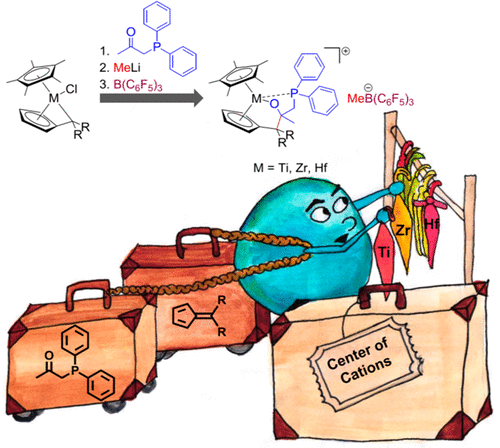当前位置:
X-MOL 学术
›
Organometallics
›
论文详情
Our official English website, www.x-mol.net, welcomes your
feedback! (Note: you will need to create a separate account there.)
Electrophilic d0 Cations of Group 4 Metals (M = Ti, Zr, Hf) Derived from Monopentafulvene Complexes: Direct Formation of Tridentate Cp,O,P-Ligands
Organometallics ( IF 2.5 ) Pub Date : 2018-03-16 00:00:00 , DOI: 10.1021/acs.organomet.8b00088 Malte Fischer 1 , Raoul Schaper 1 , Maximilian Jaugstetter 1 , Marc Schmidtmann 1 , Rüdiger Beckhaus 1
Organometallics ( IF 2.5 ) Pub Date : 2018-03-16 00:00:00 , DOI: 10.1021/acs.organomet.8b00088 Malte Fischer 1 , Raoul Schaper 1 , Maximilian Jaugstetter 1 , Marc Schmidtmann 1 , Rüdiger Beckhaus 1
Affiliation

|
The reactions of the monopentafulvene complexes Ti1a and Ti1b with the general formula [Cp*Ti(Cl)(π-η5:σ-η1-C5H4═CR2)] (R = p-tolyl (Ti1a); CR2 = adamantylidene (Ti1b)) with the bidentate P,O-ligand precursor L1, featuring a diphenylphosphine and a hydroxyl functional group, are reported, yielding the corresponding complexes Ti2a and Ti2b in good yields as the result of deprotonation. A chloride/methyl exchange reaction and subsequent reaction with B(C6F5)3 was envisaged to yield the corresponding cationic complexes. Instead, the methylation reactions of Ti2a and Ti2b with methyllithium or methylmagnesium bromide selectively yielded the doubly methylated titanium complexes Ti3a and Ti3b with abstraction of LiCl and the lithium salt of the bidentate P,O-ligand. To avoid this reaction, the P,O-ligand precursor L2 was prepared, featuring a carbonyl group instead of the hydroxyl functional group. This change in the general reaction sequence allowed the preparation of a new family of cationic titanium complexes Ti6a and Ti6b and was transferred to the heavier congeners zirconium (Zr4) and hafnium (Hf4). Every step of the reaction pathway was performed under mild reaction conditions and in good to very good yields. The insertion of the carbonyl group into the M–Cexo bond of the monopentafulvene complexes Ti1a, Ti1b, Zr1, and Hf1, and consequently the formation of a C–C bond, proved to be mandatory for the methylation and subsequent abstraction of the methyl group by B(C6F5)3. In effect, a tridentate Cp,O,P-ligand was directly introduced into the coordination spheres of the respective group 4 metals within the cationic complexes. In all cases the phosphorus shows a persistent interaction between the Lewis acidic metal center and the Lewis basic phosphine moiety, as shown by NMR analyses and in the solid state. Every complex was thoroughly characterized, including several X-ray diffraction analyses of each class of compounds reported here.
中文翻译:

源自单五叶富烯配合物的4族金属(M = Ti,Zr,Hf)的亲电子d 0阳离子:三齿Cp,O,P-配体的直接形成
所述monopentafulvene的反应复合物必须由TI1A和Ti1b与通式的[Cp *的Ti(Cl)的(π-η 5:σ-η 1 -C 5 ħ 4 = CR 2)](R = p -甲苯基(必须由TI1A);据报道,CR 2 =金刚烷(Ti1b),具有二齿P,O-配体前体L1具有二苯基膦和羟基官能团,产生相应的配合物Ti2a和Ti2b去质子化的结果,收率很高。设想氯化物/甲基交换反应以及随后与B(C 6 F 5)3的反应以产生相应的阳离子络合物。取而代之的是,Ti2a和Ti2b与甲基锂或甲基溴化镁的甲基化反应选择性地产生了双甲基化的钛络合物Ti3a和Ti3b,并提取了LiCl和二齿P,O-配体的锂盐。为避免该反应,P,O-配体前体L2制备了以羰基代替羟基官能团为特征的化合物。一般反应顺序的这种变化允许制备新的阳离子钛络合物系列Ti6a和Ti6b,并被转移到较重的同族元素锆(Zr4)和ha(Hf4)中。反应路径的每个步骤均在温和的反应条件下进行,并且收率很高。羰基插入单五烯富烯配合物Ti1a,Ti1b,Zr1和Hf1的M–C外键中,并因此形成C–C键,对于B(C 6 F 5)3的甲基化和随后的甲基抽象化是必不可少的。实际上,将三齿的Cp,O,P-配体直接引入阳离子络合物中各个4族金属的配位球中。在所有情况下,磷均显示路易斯酸性金属中心与路易斯碱性膦部分之间的持久相互作用,如NMR分析所示和处于固态。每个复合物都经过了彻底的表征,包括对这里报道的每类化合物进行的X射线衍射分析。
更新日期:2018-03-16
中文翻译:

源自单五叶富烯配合物的4族金属(M = Ti,Zr,Hf)的亲电子d 0阳离子:三齿Cp,O,P-配体的直接形成
所述monopentafulvene的反应复合物必须由TI1A和Ti1b与通式的[Cp *的Ti(Cl)的(π-η 5:σ-η 1 -C 5 ħ 4 = CR 2)](R = p -甲苯基(必须由TI1A);据报道,CR 2 =金刚烷(Ti1b),具有二齿P,O-配体前体L1具有二苯基膦和羟基官能团,产生相应的配合物Ti2a和Ti2b去质子化的结果,收率很高。设想氯化物/甲基交换反应以及随后与B(C 6 F 5)3的反应以产生相应的阳离子络合物。取而代之的是,Ti2a和Ti2b与甲基锂或甲基溴化镁的甲基化反应选择性地产生了双甲基化的钛络合物Ti3a和Ti3b,并提取了LiCl和二齿P,O-配体的锂盐。为避免该反应,P,O-配体前体L2制备了以羰基代替羟基官能团为特征的化合物。一般反应顺序的这种变化允许制备新的阳离子钛络合物系列Ti6a和Ti6b,并被转移到较重的同族元素锆(Zr4)和ha(Hf4)中。反应路径的每个步骤均在温和的反应条件下进行,并且收率很高。羰基插入单五烯富烯配合物Ti1a,Ti1b,Zr1和Hf1的M–C外键中,并因此形成C–C键,对于B(C 6 F 5)3的甲基化和随后的甲基抽象化是必不可少的。实际上,将三齿的Cp,O,P-配体直接引入阳离子络合物中各个4族金属的配位球中。在所有情况下,磷均显示路易斯酸性金属中心与路易斯碱性膦部分之间的持久相互作用,如NMR分析所示和处于固态。每个复合物都经过了彻底的表征,包括对这里报道的每类化合物进行的X射线衍射分析。











































 京公网安备 11010802027423号
京公网安备 11010802027423号